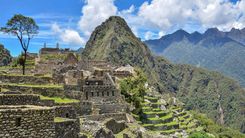Despite the political problems of the last few years, most people on the streets of Ayacucho, although quiet and reserved (seemingly saving their energy for the city’s boisterous fiestas), are helpful, friendly and kind. You’ll find few people speak any English; Quechua is the city’s first language, though most of the town’s inhabitants can also speak some Spanish.
Brief history
Ayacucho was the centre of the Huari culture, which emerged in the region around 700 AD and spread its powerful and evocative religious symbolism throughout most of Peru over the next three or four hundred years. After the demise of the Huari, the ancient city later became a major Inca administrative centre. The Spanish originally selected a different nearby site for the city at Huamanguilla; but this was abandoned in 1540 in favour of the present location. Ayacucho’s strategic location, vitally important to both the Incas and the Spanish colonials, meant that the city grew very wealthy as miners and administrators decided to put down roots here, eventually sponsoring the exquisite and unique wealth of the city’s churches, which demonstrate the clearly high level of masonic and woodworking skills of the local craftspeople.
The bloody Battle of Ayacucho, which took place near here on the Pampa de Quinoa in 1824, finally released Peru from the shackles of Spain. The armies met early in December, when Viceroy José de la Serna attacked Sucre’s Republican force in three columns. The pro-Spanish soldiers were, however, unable to hold off the Republican forces who captured the viceroy with relative ease. Ayacucho was the last part of Peru to be liberated from colonial power.
Though quiet these days, Ayacucho was also a radical university town with a left-wing tradition going back at least fifty years, known around the world for the civil war between terrorists and the Peruvian armed forces during the 1980s (see Plaza de Armas). Most civilians in the region remember this era as one where they were trapped between two evils – the terrorists on the one hand and the retaliatory military on the other. Because of this, several villages were annihilated by one side or the other. A large proportion of villagers from remote settlements in the region consequently decided to leave the area, which they hoped would offer them relative safety. Despite efforts by Fujimori’s government to rehabilitate these communities and entice people back from Lima to their rural homes in the 1990s, many of them remain in the capital today.
Arts and crafts
Many visitors come for Ayacucho’s thriving craft industry, mainly woven rugs and retablos (finely worked little wooden boxes containing intricate three-dimensional religious scenes made mainly from papier-mâché). If you’ve got the time to spare, however, it’s more interesting and less expensive to visit some of the actual craft workshops and buy from the artisans themselves. Most of these workshops are found in the barrio of Santa Ana, just uphill from the Plaza de Armas: locals are always happy to guide visitors in the right direction. Some of the best-quality retablos are not all that expensive, but if you want one of their more complicated modern pieces it could cost as much as $300, and take up to three months to complete.
Rugs
Edwin Sulca – arguably the best known weaver here – lives opposite the church on the Plaza Santa Ana; his work sells from around $100 (almost double in Lima’s shops), and many of his designs graphically depict the recent political horrors around Ayacucho.
Gerado Fernandez Palomino is another excellent weaver who has a store in his house and workshop located on Jr Paris 600, also in Santa Ana.
Alabaster carvings
Alabaster carvings – known in Peru as Huamanga stone carvings – are another speciality of Ayacucho. Try Señor Pizarro, Jr San Cristoval 215, who has a reputation as one of the best carvers in town. The craft cooperative Ahuaccllacta, Huanca Solar 130, is also worth checking out.
Artesanía markets
Head to the following: Plazoleta María Pardo de Bellido, and Jirón Libertad, blocks 7–9; the first block of Jirón Paris; second block of Pasaje Bolognesi; and the first two of Jirón Asamblea.
Festivals and music in Ayacucho
If you can be in Ayacucho for Semana Santa, the Holy Week beginning the Friday before Easter, you’ll see fabulous daily processions, pageants and nightly candlelit processions centred on the Catedral. But beware of the beautiful procession of the Virgen Dolores (Our Lady of Sorrows), which takes place the Friday before Palm Sunday: pebbles are fired at the crowd (particularly at children and foreigners) by expert slingers so that onlookers take on the pain of La Madre de Dios, and so supposedly reduce her suffering. Around May 23, there is the elaborate religious procession of the Fiesta de las Cruces, when festivities often involve the local “scissors” folkdance performed by two men, each wielding a rather dangerous pair of cutlasses.



